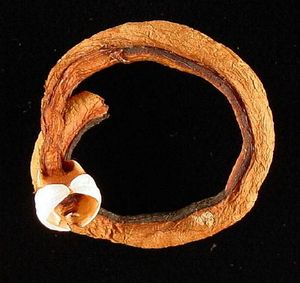Teredinibacter turnerae: Difference between revisions
Ahronflowers (talk | contribs) |
Ahronflowers (talk | contribs) |
||
| Line 1: | Line 1: | ||
''Page is currently a work in progress'' | ''Page is currently a work in progress'' | ||
==Characteristics of the symbiont/pathogen== | ==Characteristics of the symbiont/pathogen== | ||
Located in the proteobacterium family, ''Teredinibacter turnerae'' are gram-negative rods that have polar flagellum for mobility. The genome of ''T. tunerae'' has almost been completely sequenced, containing 1,453 base pairs. | Located in the proteobacterium family, ''Teredinibacter turnerae'' are gram-negative rods that have polar flagellum for mobility. The genome of ''T. tunerae'' has almost been completely sequenced, containing 1,453 base pairs. It is closely related to ''Saccharophagus degradans''[link]. | ||
==Characteristics of the host== | ==Characteristics of the host== | ||
Revision as of 17:53, 18 November 2011
Page is currently a work in progress
Characteristics of the symbiont/pathogen
Located in the proteobacterium family, Teredinibacter turnerae are gram-negative rods that have polar flagellum for mobility. The genome of T. tunerae has almost been completely sequenced, containing 1,453 base pairs. It is closely related to Saccharophagus degradans[link].
Characteristics of the host
Commonly known as "shipworms" because they digest the wood immersed in salt water, Lyrodus pedicellatus are small salt water clams with small shells. Even thought they look like worms, they are not actually worms. There are 300 species of Teredindiae, the shipworm family, which all have a Deshayes. Deshayes is a special organ where the digestion of cellulose (wood) occurs.

Host-Symbiont Interaction
The symbiosis between T. turnerae and L. pedicellatus is assumed to be a mutualism because there is no direct evidence supporting that T. turnerae benefits from the relationship.
T. turnerae has 2 enzymes important for L. pedicellatus. T. turnerae has cellulase which breaks down cellulose, the carbohydrate found in wood. Since this metabolism occurs in teh Deshayes of the shipworm, evidence supports that T. turnerae thrives in the special organ of the shipworm. T. turnerae also undergoes nitrogen fixation and has the enzyme nitrogenase to break down nitrogen into ammonia. Nitrogen fixation gives L. pedicellatus a source of nitrogen.
Studies have shown that T. turnerae are endosymbionts and are obligative faculative. This is due to the fact that T. turnerae have not lost any of its genes so it is able to thrive outside L. pedicellatus, even though there is has not been any evidence supporting that T. turnerae has been found in an environment outside L. pedicellatus.
Molecular Insights into the Symbiosis
Describe molecular/genetic studies on the symbiosis.
Ecological and Evolutionary Aspects
What is the evolutionary history of the interaction? Do particular environmental factors play a role in regulating the symbiosis?
Recent Discoveries
Describe two findings on the symbiosis published within the last two years.
References
[Sample reference] [[2] Seemanapalli SV, Xu Q, McShan K, Liang FT. 2010. Outer surface protein C is a dissemination-facilitating factor of Borrelia burgdorferi during mammalian infection. PLoS One 5:e15830.]
Edited by [Ahron Flowers], students of Grace Lim-Fong
This template is just a general guideline of how to design your site. You are not restricted to this format, so feel free to make changes to the headings and subheadings and to add or remove sections as appropriate.
